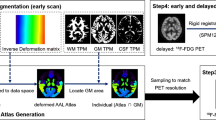Abstract
Among the therapeutic options of drug-resistant focal epilepsies, surgical treatment is the most effective treatment, provided that the location of the epileptogenic area is identified. Among the imaging modalities, MRI represents the fundamental method for the identification of structural lesions. However, despite the continuous technical progress of the equipment, a significant proportion of patients do not present recognizable alterations with MRI. PET with 18F-FDG is a method of investigation of cerebral metabolism and can be useful to identify the epileptogenic area and the extension of the epileptogenic network. In this pictorial essay, the role of PET is briefly reported and some representative clinical cases presented. In epilepsies of the mesial temporal lobe, PET is useful for confirming the laterality of the epileptogenic area and for confirming the cases of bi-temporal epilepsy, in which surgery is contraindicated, as well as to recognize remote areas of altered metabolism that could change the planning of surgery. In extra-temporal focal epilepsies, 18F-FDG PET can detect focal metabolism alterations indicative of lesions such as focal cortical dysplasia, even when the MRI is negative. However, for the correct interpretation of 18F-FDG, MRI is necessary. With the use of PET/MRI hybrid devices, the best accuracy of PET is obtained, but the use of registration softwares is, however, suitable for the purpose of accurately identifying the cerebral cortex and avoiding errors in the interpretation of PET. The text describes the protocol for acquiring and recording MRI and 18F-FDG images for clinical use in use in our Department of Pre-surgical Diagnostics.












Similar content being viewed by others
References
Guerrini R, Scerrati M, Rubboli G et al (2013) Overview of presurgical assessment and surgical treatment of epilepsy from the Italian League Against Epilepsy. Epilepsia 54(Suppl 7):35–48. https://doi.org/10.1111/epi.12308
Jones AL, Cascino GD (2016) Evidence on use of neuroimaging for surgical treatment of temporal lobe epilepsy. JAMA Neurol 73:464. https://doi.org/10.1001/jamaneurol.2015.4996
Craven IJ, Griffiths PD, Bhattacharyya D et al (2012) 3.0 T MRI of 2000 consecutive patients with localisation-related epilepsy. Br J Radiol 85:1236–1242. https://doi.org/10.1259/bjr/30177037
De Ciantis A, Barba C, Tassi L et al (2016) 7T MRI in focal epilepsy with unrevealing conventional field strength imaging. Epilepsia 57:445–454. https://doi.org/10.1111/epi.13313
Engel J, Kuhl DE, Phelps ME, Mazziotta JC (1982) Interictal cerebral glucose metabolism in partial epilepsy and its relation to EEG changes. Ann Neurol 12:510–517. https://doi.org/10.1002/ana.410120603
Theodore WH, Newmark ME, Sato S et al (1983) [18F]fluorodeoxyglucose positron emission tomography in refractory complex partial seizures. Ann Neurol 14:429–437. https://doi.org/10.1002/ana.410140406
Lamarche F, Job A-S, Deman P et al (2016) Correlation of FDG-PET hypometabolism and SEEG epileptogenicity mapping in patients with drug-resistant focal epilepsy. Epilepsia 57:2045–2055. https://doi.org/10.1111/epi.13592
Thom M (2014) Review: Hippocampal sclerosis in epilepsy: a neuropathology review. Neuropathol Appl Neurobiol 40:520–543. https://doi.org/10.1111/nan.12150
Gok B, Jallo G, Hayeri R et al (2013) The evaluation of FDG-PET imaging for epileptogenic focus localization in patients with MRI positive and MRI negative temporal lobe epilepsy. Neuroradiology 55:541–550. https://doi.org/10.1007/s00234-012-1121-x
Leiva-Salinas C, Quigg M, Elias WJ et al (2017) Earlier seizure onset and longer epilepsy duration correlate with the degree of temporal hypometabolism in patients with mesial temporal lobe sclerosis. Epilepsy Res 138:105–109. https://doi.org/10.1016/j.eplepsyres.2017.10.023
Josephson CB, Dykeman J, Fiest KM et al (2013) Systematic review and meta-analysis of standard vs selective temporal lobe epilepsy surgery. Neurology 80:1669–1676. https://doi.org/10.1212/WNL.0b013e3182904f82
Kamm J, Boles Ponto LL, Manzel K et al (2018) Temporal lobe asymmetry in FDG-PET uptake predicts neuropsychological and seizure outcomes after temporal lobectomy. Epilepsy Behav 78:62–67. https://doi.org/10.1016/j.yebeh.2017.10.006
Najm I, Jehi L, Palmini A et al (2013) Temporal patterns and mechanisms of epilepsy surgery failure. Epilepsia 54:772–782. https://doi.org/10.1111/epi.12152
Keller SS, Richardson MP, Schoene-Bake J-C et al (2015) Thalamotemporal alteration and postoperative seizures in temporal lobe epilepsy. Ann Neurol 77:760–774. https://doi.org/10.1002/ana.24376
Zachenhofer I, Novak K, Baumgartner C et al (2011) Reoperation after selective amygdalohippocampectomy: an MRI analysis of the extent of temporomesial resection in ten cases. Acta Neurochirurgica 153:239–248. https://doi.org/10.1007/s00701-010-0802-7
Lee JJ, Lee SK, Lee S-Y et al (2008) Frontal lobe epilepsy: clinical characteristics, surgical outcomes and diagnostic modalities. Seizure 17:514–523. https://doi.org/10.1016/j.seizure.2008.01.007
Wong CH, Bleasel A, Wen L et al (2010) The topography and significance of extratemporal hypometabolism in refractory mesial temporal lobe epilepsy examined by FDG-PET. Epilepsia 51:1365–1373. https://doi.org/10.1111/j.1528-1167.2010.02552.x
Mirandola L, Mai RF, Francione S et al (2017) Stereo-EEG: Diagnostic and therapeutic tool for periventricular nodular heterotopia epilepsies. Epilepsia 58:1962–1971. https://doi.org/10.1111/epi.13895
Lee KK, Salamon N (2009) [18F] fluorodeoxyglucose-positron-emission tomography and MR imaging coregistration for presurgical evaluation of medically refractory epilepsy. AJNR Am J Neuroradiol 30:1811–1816. https://doi.org/10.3174/ajnr.A1637
Nabavizadeh SA, Nasrallah I, Dubroff J (2017) Emerging PET/MRI applications in neuroradiology and neuroscience. Clin Transl Imaging 5:121–133. https://doi.org/10.1007/s40336-016-0209-4
Author information
Authors and Affiliations
Contributions
All the authors contributed equally to the literature review, planning, writing of the text, selection and preparation of the cases presented.
Corresponding author
Ethics declarations
Conflict of interest
Angelo Del Sole, Chiara Pastori, Giuseppe Didato and Laura Tassi declare no conflict of interest.
Informed consent
All the patients gave written consent to the publication of their PET images in anonymous form.
Additional information
Publisher's Note
Springer Nature remains neutral with regard to jurisdictional claims in published maps and institutional affiliations.
Rights and permissions
About this article
Cite this article
Del Sole, A., Pastori, C., Didato, G. et al. 18F-FDG in the presurgical evaluation of epilepsies: a pictorial essay. Clin Transl Imaging 7, 219–229 (2019). https://doi.org/10.1007/s40336-019-00323-6
Received:
Accepted:
Published:
Issue Date:
DOI: https://doi.org/10.1007/s40336-019-00323-6




